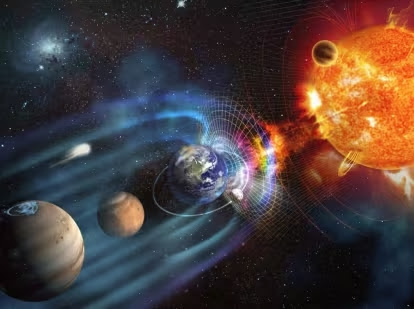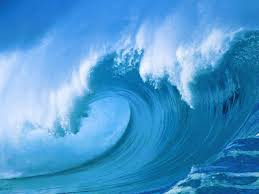GEOPHYSICS !
The paleoclimate not a direct field study of geophysics , but if they are a very interesting research topic that can start performing geophysical through Climatology . But let's start parts . What are paleoclimates ?
To begin to understand this post, the term paleoclimate is a compound word derived from the Greek " paleo " which means past or older and "climate" ( 1) , therefore , the term means paleoclimate climates are demonstrated in the past which we are talking about thousands and thousands of years ago.
But who is responsible for conducting studies of paleoclimate ? Are paleoclimate who are responsible for conducting these studies in order to try to understand what were the weather that occurred in our planet in order to have a reference of how climates could be in the future. But the paleoclimate not based on instrumental techniques , ie they do not use special equipment for their studies , instead , use natural environmental records that currently exist on our planet . What we call " proxies " . (1)
Would not it be interesting to know how was the weather in the past and use them as a pattern and track them and also use them as a tool for climatological trend ?
Then understand that aims Paleoclimatology study the climatic characteristics of the Earth throughout its history , based on natural logs to help in the derivation and explanation of the paleoclimate . ( 2) Our blog will show you what those proxies that are used to infer paleoclimates .
Begin to mention to some of them and then begin to explain how to use these to determine the paleoclimate proxies .
The information we need can remove various proxies such as ice cores , corals, speleothems , rings of tree trunks , pollen, varves or groundwater. They are examples to mention that we serve to determine the Earth's paleoclimate .
When we refer of ice cores palaeoclimatologist understand that the ice cores used for analysis in the laboratory. The ice that extract large do deep drilling in high mountains or in the polar regions . And why do they do it? Is that this ice has been accumulating removed layer upon layer for many centuries. Deep ice is drilled and sampled these witnesses . And what is the usefulness of these witnesses? These ice cores have certain indicators that will help us in our study paleoclimatológico , these indicators are: dust, air bubbles or oxygen isotopes , trace gas concentrations , chemical impurities from land and marine aerosols cosmogenic isotopes and origin volcanic desert human ( 3). Besides , small meteorites , volcanic ash .
Oxygen isotopes , dust and air bubbles to help us interpret past climate coring area also indicating paleoamosférica composition . These data give us vision was to determine how the dynamics of the atmosphere , showing the appreciation of the speed of the winds. Isotopic analysis of the ice may be related to variations in temperature and sea level. One thing which is very important are the variations of CO2 present in the air bubbles to determine whether at the time of deglaciation was present phenomena .
At first glance it seems that everything is easy, but consider some technical issues that are very important , because when you start performing our studies of these witnesses or ice cores , enough influence on our results .
To this we must keep the following technical considerations : depending on the length of the witness must be adequate facilities to accommodate the witness , the witness maintained below the freezing point, this means average temperatures ranging from -15 ° C to avoid micro- fractures, appropriate costumes and decontaminated, special respirators , special laboratory tools and decontaminated, it must be remembered that the pressure in the ice has been at certain depths , so it is necessary to isolate the low ice core special conditions , to prevent air bubbles trapped in cores or cores with our air contamination present . (4)
When we use the corals in our study of paleoclimate , we analyzed the calcium carbonate in the coral skeleton , studying oxygen isotopes as well as minerals such as aragonite . Thus, these elements help us determine which was the temperature of the water in which lived the coral, and therefore , this temperature data will help us to reconstruct the climate of the time. ( May )
To a greater extent of information on the study of corals we invite you to visit the following web address: http://www.mendoza-conicet.gob.ar/paleo/outreach/coral
In our next post we will end this information which has become very interesting.
References .
(1) http://es.m.wikipedia.org/wiki/Paleoclima
(2) http://es.m.wikipedia.org/wiki/Paleoclimatologia
(3) http://fluidos.eia.edu.co/hidrologiaii/articuloseshii/temasvariados/paleo/paleoclima.html
(4) http://centrodeartigos.com/revista-digital-universitaria/contenido-25192.html
(5) http://www.mendoza-conicet.gob.ar/paleo/es/proxies.html
The paleoclimate not a direct field study of geophysics , but if they are a very interesting research topic that can start performing geophysical through Climatology . But let's start parts . What are paleoclimates ?
To begin to understand this post, the term paleoclimate is a compound word derived from the Greek " paleo " which means past or older and "climate" ( 1) , therefore , the term means paleoclimate climates are demonstrated in the past which we are talking about thousands and thousands of years ago.
But who is responsible for conducting studies of paleoclimate ? Are paleoclimate who are responsible for conducting these studies in order to try to understand what were the weather that occurred in our planet in order to have a reference of how climates could be in the future. But the paleoclimate not based on instrumental techniques , ie they do not use special equipment for their studies , instead , use natural environmental records that currently exist on our planet . What we call " proxies " . (1)
Would not it be interesting to know how was the weather in the past and use them as a pattern and track them and also use them as a tool for climatological trend ?
Then understand that aims Paleoclimatology study the climatic characteristics of the Earth throughout its history , based on natural logs to help in the derivation and explanation of the paleoclimate . ( 2) Our blog will show you what those proxies that are used to infer paleoclimates .
Begin to mention to some of them and then begin to explain how to use these to determine the paleoclimate proxies .
The information we need can remove various proxies such as ice cores , corals, speleothems , rings of tree trunks , pollen, varves or groundwater. They are examples to mention that we serve to determine the Earth's paleoclimate .
 |
| Ice Witness |
Oxygen isotopes , dust and air bubbles to help us interpret past climate coring area also indicating paleoamosférica composition . These data give us vision was to determine how the dynamics of the atmosphere , showing the appreciation of the speed of the winds. Isotopic analysis of the ice may be related to variations in temperature and sea level. One thing which is very important are the variations of CO2 present in the air bubbles to determine whether at the time of deglaciation was present phenomena .
At first glance it seems that everything is easy, but consider some technical issues that are very important , because when you start performing our studies of these witnesses or ice cores , enough influence on our results .
 |
| Ice core length. |
When we use the corals in our study of paleoclimate , we analyzed the calcium carbonate in the coral skeleton , studying oxygen isotopes as well as minerals such as aragonite . Thus, these elements help us determine which was the temperature of the water in which lived the coral, and therefore , this temperature data will help us to reconstruct the climate of the time. ( May )
To a greater extent of information on the study of corals we invite you to visit the following web address: http://www.mendoza-conicet.gob.ar/paleo/outreach/coral
In our next post we will end this information which has become very interesting.
References .
(1) http://es.m.wikipedia.org/wiki/Paleoclima
(2) http://es.m.wikipedia.org/wiki/Paleoclimatologia
(3) http://fluidos.eia.edu.co/hidrologiaii/articuloseshii/temasvariados/paleo/paleoclima.html
(4) http://centrodeartigos.com/revista-digital-universitaria/contenido-25192.html
(5) http://www.mendoza-conicet.gob.ar/paleo/es/proxies.html































0 Comments:
Publicar un comentario
No olvides de escribir tu opinión personal de nuestro blog, una página o información que desees comprtir. Todos los éxitos para ti. Gustavo Zavala.